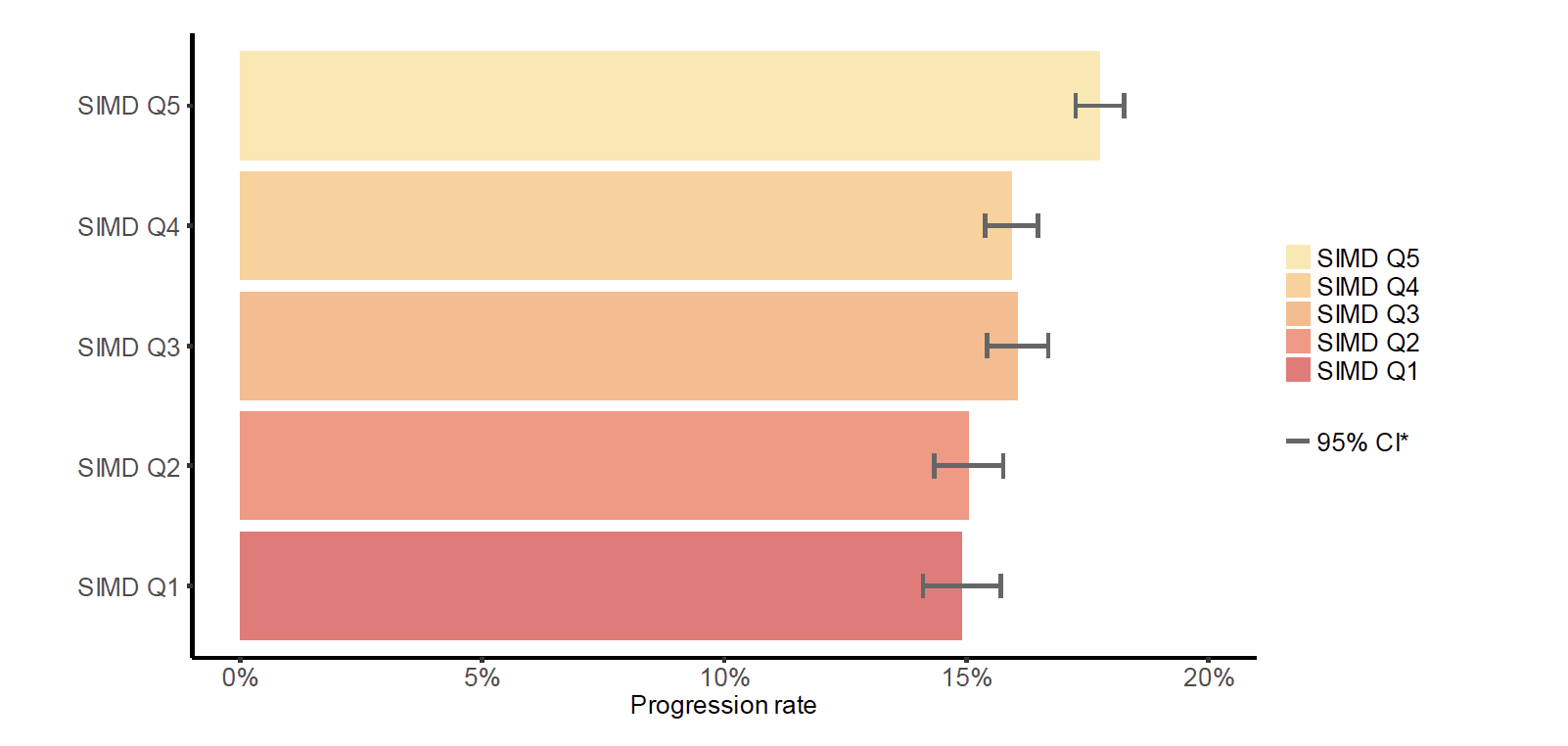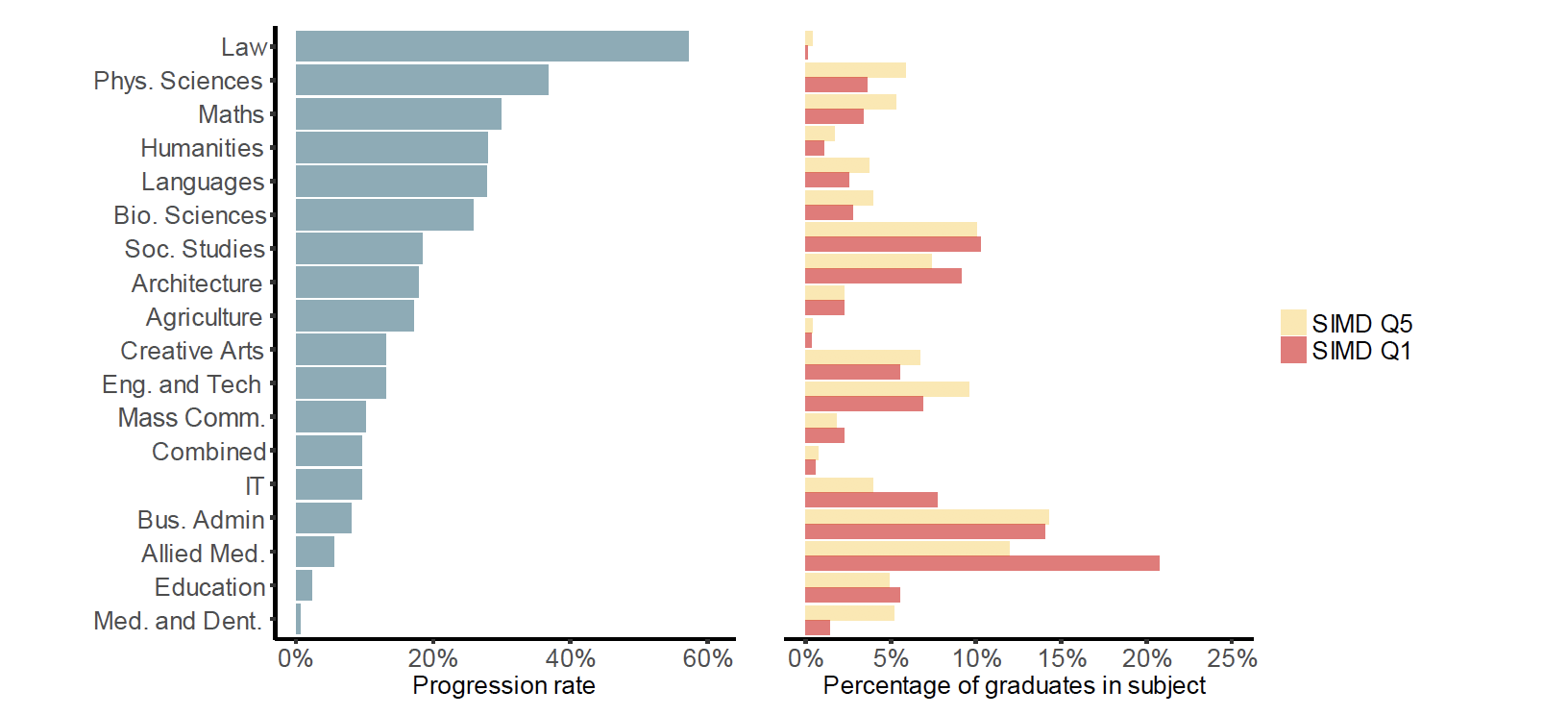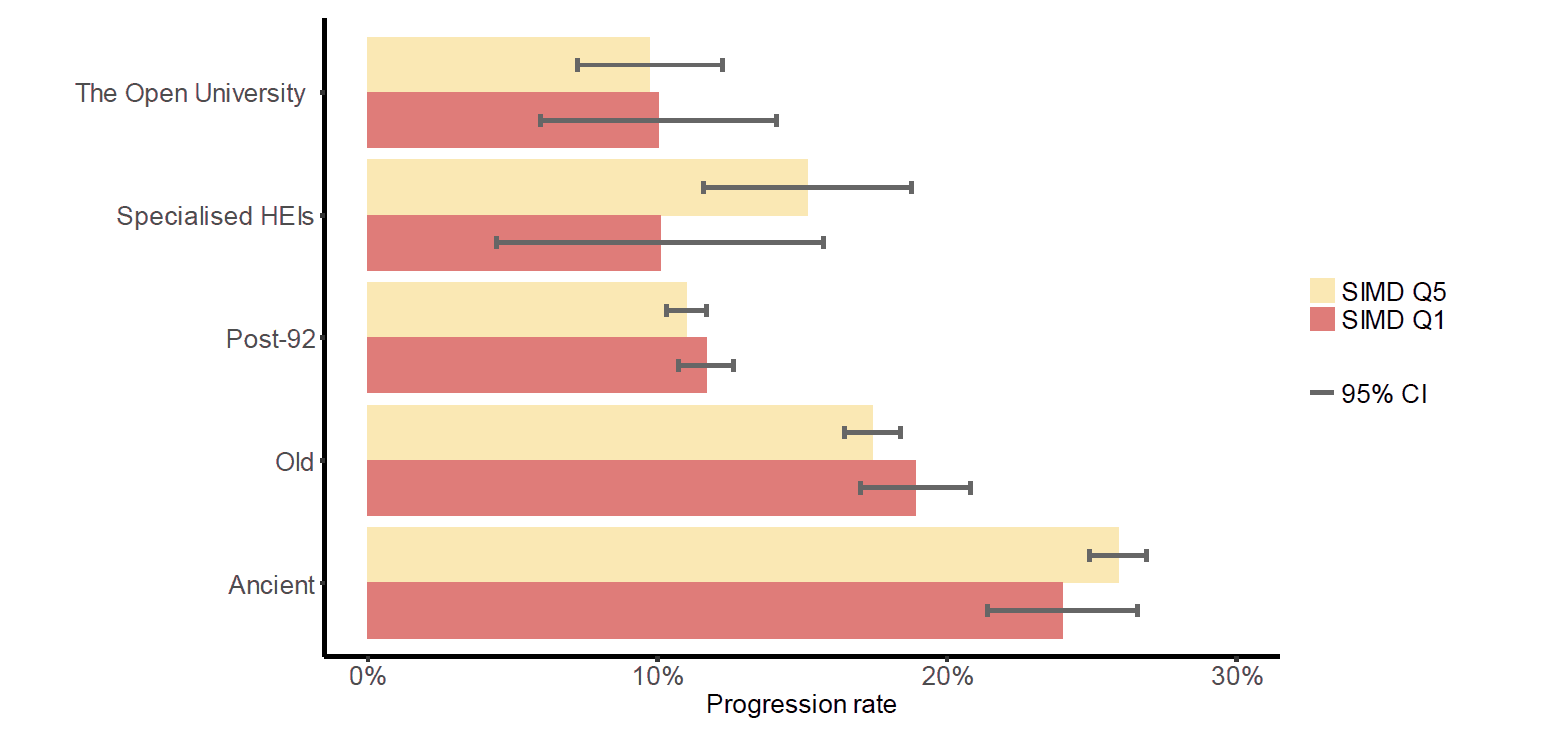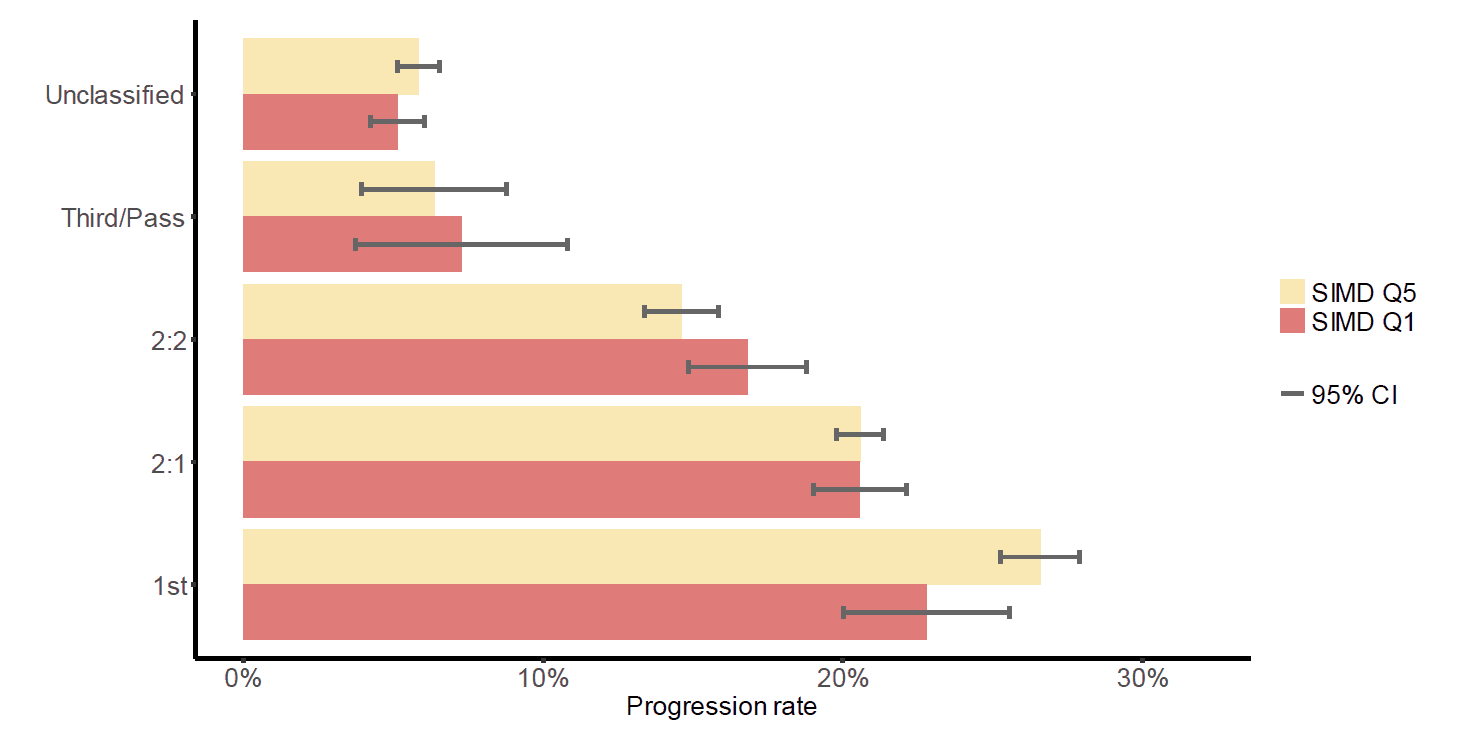Access to postgraduate study - representation and destinations: discussion paper
Independent paper from the Commissioner for Fair Access considering representation of students from the most deprived areas of Scotland in postgraduate study and their destinations.
Progression from first degree to postgraduate study
Progression analysis is carried out using four years of data (2013/14 to 2016/17) from the Higher Education Statistics Agency (HESA) Destination of Leavers from Higher Education (DLHE) survey. First degree leavers that responded to the DLHE will be referred to as (first degree) graduates throughout this analysis. Previously[4], graduates were asked to complete the survey six months after leaving university[5]. Progression rates to postgraduate study are estimated using the percentage of Scottish domiciled first degree graduates that were in full-time study, part-time study, or who were 'primarily studying and also in work' (excluding those who were in further study but aiming for a first degree or not aiming for a formal qualification[6]) six months after graduation. Graduates that were not considered as progressing may have been in any of a number of destinations including: full-time work, part-time work and unemployment.
Since the DLHE is a survey of initial destinations, progression figures do not include graduates who progress to postgraduate study six months or more after graduating. Therefore, the group of graduates who did not progress (within six months) includes a number of graduates that will enter postgraduate study in future.
Figure 2: Percentage of first degree graduates progressing to postgraduate study, by SIMD quintile
Source: HESA DLHE data (2013/14 to 2016/17)

Figure 2 shows the progression rates from first degree to postgraduate study. The figure shows that graduates from SIMD Q5 areas were (statistically) significantly more likely than their peers to continue to postgraduate provision. Although progression rates were between 14.9% (SIMD Q1) and 17.8% (SIMD Q5), the actual numbers progressing varied substantially between quintiles - due to the disparities in representation at first degree level. Between 2013/14 and 2016/17, around 3.6 times more first degree graduates were estimated as progressing to postgraduate from SIMD Q5 compared to SIMD Q1.[7]
Key points:
- Overall, first degree graduates from deprived areas are less likely to progress to postgraduate study.
The analysis that follows considers to what extent this relationship between deprivation and progression to postgraduate study is linked to other factors: subject studied, institution attended, and degree outcome.
Progression: subject studied
Figure 3 shows the progression rates of first degree graduates to postgraduate study by subject studied (at first degree). Progression to postgraduate study is not necessarily the typical or desired route for a first degree leaver – particularly in certain career tracks.[8] This means progression rates vary substantially by subject area. Qualifiers in subjects such as Medicine and Dentistry, Veterinary Science and Education are much less likely to continue into postgraduate study. Vocations in these subject areas tend to provide continued training outwith Higher Education institutions. On the other hand, other subject areas such as Physical Sciences and Mathematics have high rates of progression, 37% and 30% respectively. First degree Law graduates have the highest progression rate among subject areas (57%), likely since postgraduate legal provision - which is typically required to complete legal training[9] - is undertaken in universities.
To explore how subject and SIMD interact in progression, Figure 4 shows the subject distribution of first degree graduates by SIMD quintile (Q1/Q5), ordered by subject progression rate as in Figure 3. Graduates from Q5 areas were relatively much more likely to be studying Law or Physical Sciences, among other subjects with the highest progression rates (Figure 3). To illustrate this, among graduates that progressed to postgraduate study, 32% of all those from Q5 areas, and 20% of those from Q1 areas were from these two subjects. On the other hand, graduates from Q1 areas were relatively much more likely to be studying Subjects Allied to Medicine or IT – both subjects with relatively low progression rates (5% and 10%, respectively). These observations suggest that subject studied is partially driving differences in progression between those from Q1 and Q5 areas. Despite this, progression rates still vary substantially by SIMD for a few subjects. In Law, a subject with a relatively low number of first degree graduates from Q1 areas in the first instance, 50% of first degree graduates from SIMD Q1 areas progressed to postgraduate study compared to 61% of Q5 graduates.
Figure 3 (left): Percentage of first degree graduates progressing to postgraduate study, by subject
Figure 4 (right): Subject distribution of first degree graduates, by SIMD quintile (Q1/Q5)

Source: HESA DLHE data (2013/14 to 2016/17)
Key points:
- Subject studied appears to be strongly linked to the SIMD inequality in progression rates. Graduates from deprived areas are less likely to be studying subjects with the highest progression rates and are concentrated in subjects where graduates tend not to progress to postgraduate study.
- However, a small SIMD Q5 'premium' still exists in progression when accounting for subject alone. In certain subjects such as Law, where around 6 times as many SIMD Q5 than SIMD Q1 first degree graduates progressed, differences in progression remain between graduates from the 20% least and 20% most deprived areas. This premium can be accounted for by the institutions typically attended and degree outcomes of Q5 students.
- If SIMD Q1 graduates were distributed in the same subjects as SIMD Q5 graduates, based on their subject progression rates the overall progression rate for SIMD Q1 graduates would be 17.1% (an increase from 14.9% but still slightly lower than the SIMD Q5 rate of 17.8%).
Progression: institution attended
Data is presented below by institution type[10], rather than for individual institutions, for analytical purposes and to allow direct comparisons with previous discussion papers. Moreover, the numbers progressing from particular institutions may be skewed by subjects offered and are in most cases too small to allow for meaningful analysis by SIMD breakdown.
Figure 5 shows the percentage of first degree graduates progressing to postgraduate study by SIMD quintile (Q1/Q5) and institution type (at first degree). Graduates from Ancient universities were markedly more likely to continue to postgraduate study, with over a quarter of graduates continuing their study. On the other hand, Post-92 graduates were less than half as likely as graduates from Ancient universities to progress to postgraduate study, regardless of socio-economic background. Substantially less stark patterns in progression exist between those from the least and most deprived areas once institution type is taken into account.
Figure 5: Percentage of first degree graduates progressing to postgraduate study, by institution type and SIMD quintile (Q1/Q5)
Source: HESA DLHE data (2013/14 to 2016/17)

Chart 1 in the Commissioner for Fair Access discussion paper on 'Retention, outcomes and destinations' showed that students from SIMD Q1 were relatively more likely to attend Post-92 institutions than Ancient universities. Indeed, between 2013/14 and 2016/17, 60% of SIMD Q1 graduates who responded to the DLHE were at Post-92 institutions and 14% were at Ancient universities, compared to 36% and 34% for SIMD Q5 graduates respectively. This suggests that the overall disparity in progression between first degree graduates from the most and least deprived areas is linked to the fact that SIMD Q1 graduates are concentrated in Post-92 institutions.
Key points:
- Institution attended contributes a large extent of the SIMD-related inequality when it is solely accounted for. First degree graduates from the most deprived areas are four times more likely to be at Post-92 institutions than Ancient universities, and progression rates to postgraduate study are relatively low among Post 92 graduates regardless of SIMD quintile.
- When accounting for institution attended alone, the SIMD effect on progression is no longer statistically significant. However, first degree graduates from the 20% most deprived areas have been historically underrepresented in Ancient universities – in which graduates are more likely to progress to postgraduate study - making up 6% of graduates from these institutions between 2013/14 and 2016/17.
- If SIMD Q1 graduates were distributed in the same institution types as SIMD Q5 graduates, based on their institution type progression rates the SIMD Q1 overall progression rate would be 17.7% (an increase from 14.9% and not considerably less than the SIMD Q5 rate of 17.8%).
Progression: degree outcome
Figure 6 shows the percentage of first degree graduates who progressed to postgraduate study by SIMD quintile (Q1/Q5) and first degree outcome. It is evident that graduates with higher classifications are generally more likely to progress to postgraduate study. Moreover, the figure highlights relatively large differences that exist between students achieving a first class degree: those from Q1 areas progressed at a lower rate than those from Q5 areas (23% and 27% respectively).
Figure 6: Percentage of first degree graduates progressing to postgraduate study, by degree outcome and SIMD quintile (Q1/Q5)
Source: HESA DLHE data (2013/14 to 2016/17)

In the Commissioner for Fair Access discussion paper on 'Retention, outcomes and destinations', it was shown that students from SIMD Q1 areas are much more likely to obtain an unclassified degree, and much less likely to obtain a 2:1 or above. This suggests that the progression rates by SIMD quintile shown in Figure 2 are related to degree outcomes obtained: students with higher degree outcomes are more likely to progress to postgraduate study and students from Q1 areas are less likely to obtain higher degree outcomes than those from Q5 areas.
Key points:
- Degree class alone accounts for some, but not all, of the SIMD-related inequality in progression. Graduates from deprived areas are less likely to obtain higher degree outcomes, for which postgraduate progression rates are highest. However, among those achieving the highest degree outcome (First class), students from Q1 areas are still less likely to progress to postgraduate study. This is likely due to the subjects typically studied and institutions typically attended by Q1 graduates.
- If SIMD Q1 graduates had the same degree outcome distribution as SIMD Q5 graduates, based on their degree outcome progression rates the overall SIMD Q1 progression rate would be 17.2% (an increase from 14.9% but still lower than the SIMD Q5 rate of 17.8%).
Summary of progression analysis
There are considerable differences in progression rates between those attending different institutions, studying different subjects and by degree outcome obtained. Analysis suggests that these factors are strongly linked to both SIMD and whether or not a first degree graduate progresses to postgraduate study. Those from deprived areas are less likely to attend university in the first instance; are generally less likely to study certain subjects or attend certain institutions where rates of progression to postgraduate study are high; have lower retention in first degree study; and achieve lower classifications upon qualifying.
Any of the three factors considered in the above analysis appears to constitute a great extent of the SIMD gap in progression when accounted for alone. However, when subject, institution and degree outcome are all accounted for, further analysis shows that there is no significant difference in the progression rate between those from Q1 and those from Q5. Moreover, each of these factors (subject, institution, degree outcome) still explain significant differences in progression when accounting for the other two factors. This suggests that the inequality in progression rates between SIMD Q1 and SIMD Q5 is manifested in a combination of these (and potentially other) factors.
Contact
There is a problem
Thanks for your feedback